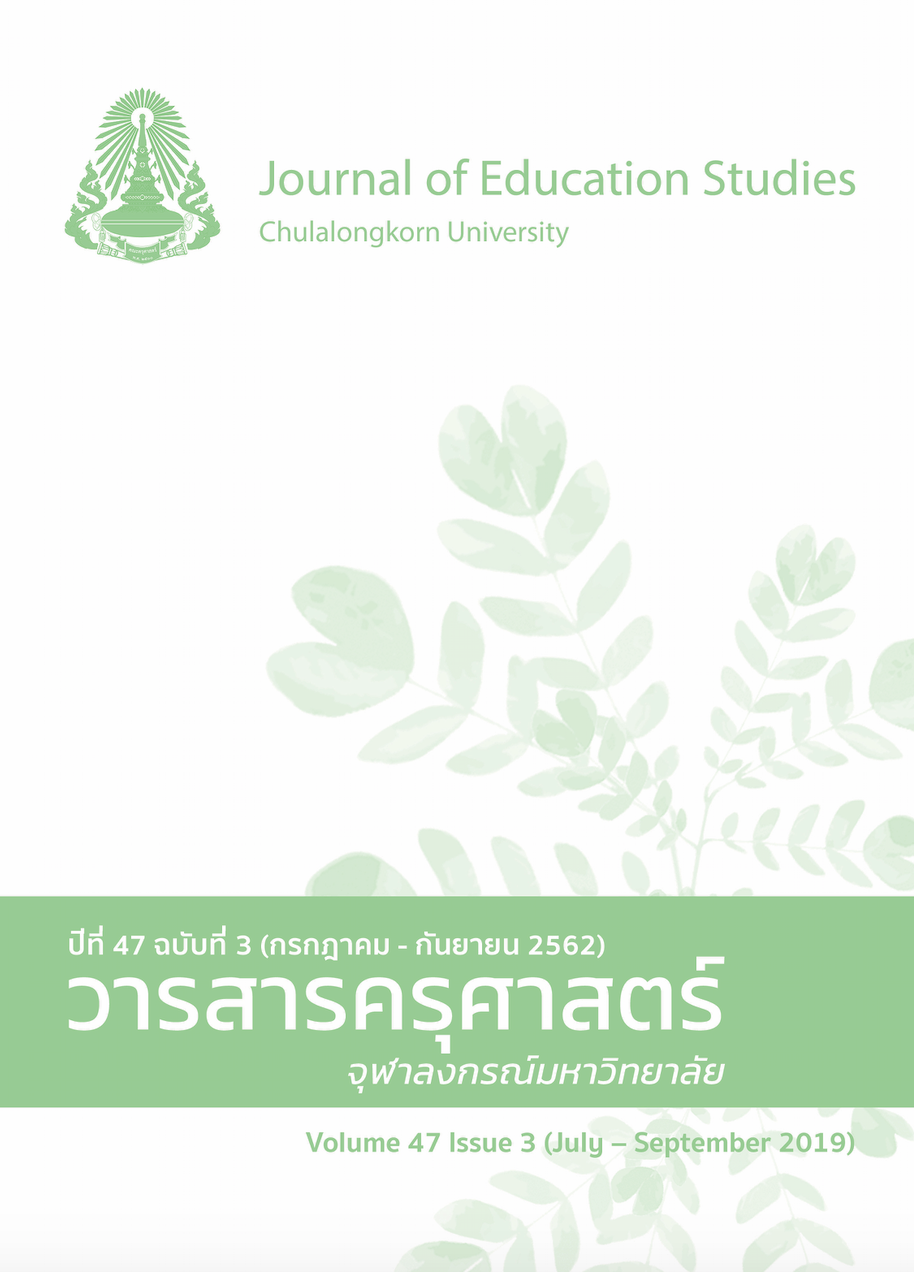The Application of Flipped Classroom Learning for Developing Teaching Readiness of Early Childhood Student Teachers
Keywords:
FLIPPED CLASSROOM LEARNING, TEACHING READINESS, EARLY CHILDHOOD STUDENT TEACHERSAbstract
Flipped classroom learning is now famous as widely accepted for application in teaching for various subjects and levels in diverse areas. Learning through this technique is helpful for learners to become part of the learning process as they have choices to discover and present knowledge from outside the classroom. It could be argued that this type of learning gives more meaning. It also allows teacher students to develop their skills through various techniques that enhance their confidence and ready them for future teaching.
The aim of this article is to present the application of flipped classroom learning for Early Childhood student teachers and integrate it with coaching strategies, teaching strategies, reflecting strategies, and the lesson plan objectives. The four steps of this learning are as follows: 1) introduction, 2) preparation, 3) presentation in which students practice skills in conveying various knowledge, lecturing, demonstrating, and role playing, and 4) discussion. Although teacher students may be satisfied with flipped classroom learning, but may still not be accustomed to it. Thus, the teacher’s role is still important as a supporter and advisor for their students.
References
ภาษาไทย
เก็จกนก เอื้อวงศ์. (2559). การชี้แนะ: การประยุกต์ใช้เพื่อการนิเทศการศึกษา. วารสารศึกษาศาสตร์ มหาวิทยาลัยสุโขทัยธรรมาธิราช, 9(2), 1-13.
คณะศึกษาศาสตร์ มหาวิทยาลัยวงษ์ชวลิตกุล. (2556). หลักสูตรศึกษาศาสตรบัณฑิต สาขาวิชาการศึกษาปฐมวัย (5 ปี). นครราชสีมา: คณะศึกษาศาสตร์ มหาวิทยาลัยวงษ์ชวลิตกุล.
ทิศนา แขมมณี. (2557, 10 พฤศจิกายน). ปลุกโลกการสอนให้มีชีวิตสู่ห้องเรียนแห่งศตวรรษใหม่. สืบค้นจาก http://resource.thaihealth.or.th/library/academic/14446
ทวีศักดิ์ จินดานุรักษ์. (2560). ครูและนักเรียนในยุค 4.0. วารสารศึกษาศาสตร์ มหาวิทยาลัยสุโขทัยธรรมาธิราช, 10(1), 214-229.
นฤมล บุญนิม. (2544). การศึกษาคุณลักษณะและกระบวนการถ่ายทอดของครูไทยในอดีตและปัจจุบัน (วิทยานิพนธ์ปริญญาดุษฎีบัณฑิต). สืบค้นจาก http://cuir.car.chula.ac.th/handle/123456789/11588
นิชาภา บุรีกาญจน์. (2556). ผลการจัดการเรียนรู้วิชาสุขศึกษาโดยใช้แนวคิดแบบห้องเรียนกลับด้านที่มีผลต่อความรับผิดชอบและผลสัมฤทธิ์ทางการเรียนของนักเรียนมัธยมศึกษาตอนต้น (วิทยานิพนธ์ปริญญามหาบัณฑิต). สืบค้นจาก http://cuir.car.chula.ac.th/handle/123456789/43130
วัลภา สบายยิ่ง. (2560). จิตวิทยาพัฒนาการวัยรุ่น. ใน ลัดดาวรรณ ณ ระนอง (บ.ก.), เอกสารการสอนชุดวิชาจิตวิทยาและวิทยาการการเรียนรู้. (น. 2-1–2-52). นนทบุรี: สำนักพิมพ์มหาวิทยาลัยสุโขทัยธรรมาธิราช.
วิจารณ์ พานิช. (2556). ครูเพื่อศิษย์สร้างห้องเรียนกลับทาง. กรุงเทพมหานคร: มูลนิธิสยามกัมมาจล.
ศศิลักษณ์ ขยันกิจ และ บุษบง ตันติวงศ์. (2559). การประเมินอย่างใคร่ครวญต่อเด็กปฐมวัย: แนวคิดและการปฏิบัติเพื่อสนับสนุนการเรียนรู้. กรุงเทพมหานคร: สำนักพิมพ์แห่งจุฬาลงกรณ์มหาวิทยาลัย.
สมพร ชาลีเครือ, วิไลวรรณ จัณณรงค์, สายพิณ อัครปัทมานนท์, จิราวรรณ สีเหลื่อม, วัลภา สถิรพันธุ์, อารีลักษณ์ ประการแก้ว, และ นิภาพร ใจปานแก่น. (2561). การศึกษาสภาพปัญหาเพื่อสร้างแนวทางการฝึก ประสบการณ์วิชาชีพครู สำหรับหลักสูตรการศึกษาปฐมวัย (5 ปี) คณะศึกษาศาสตร์ มหาวิทยลัยวงษ์ ชวลิตกุล. ใน รายงานการประชุมวิชาการะดับชาติ สาขาวิชา ศึกษาศาสตร์ ครั้งที่ 2: ความท้าทายการจัดการศึกษาไทยยุค 4.0. (น. 263-271). นครราชสีมา: สมาคมสถาบันอุดมศึกษาเอกชนแห่งประเทศไทย.
สุพรทิพย์ ธนภัทรโชติวัต, อมรรัตน์ วัฒนาธร, เทียมจันทร์ พานิชย์ผลินไชย, และ ปกรณ์ ประจันบาน. (2558). การพัฒนารูปแบบการจัดประสบการณ์วิชาชีพครูเพื่อส่งเสริมคุณลักษณะครูในศตวรรษที่ 21. วารสารศึกษาศาสตร์ มหาวิทยาลัยนเรศวร, 17(1), 33-48.
สุรศักดิ์ ปาเฮ. (2556). ห้องเรียนกลับทาง: ห้องเรียนมิติใหม่ในศตวรรษที่ 21. สืบค้นจาก http://phd.mbuisc.ac.th/academic/flipped%20classroom2.pdf2556
ภาษาอังกฤษ
Bergmann, J., & Sams, A. (2014). The flipped classroom. Computer Science Education, 17(3), 24-27.
Helgevold, N., & Moen, V. (2015). The use of flipped classrooms to stimulate students’ participation in an academic course in initial teacher education. Nordic Journal of Digital Literacy, 1(10), 29-44.
Karlsson, G., & Janson, S. (2016). The flipped classroom: A model for active student learning. Retrieved from http://www.portlandpresspublishing.com/sites/default/files/Editorial/Wen
ner/PPL_Wenner_Ch11.pdf
State University of New York. (2019). The learning pyramid. Retrieved from http://www.fitnyc.edu/cet/adjunct-faculty/learning-pyramid.php




